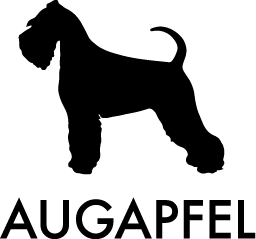Schnauzers are generally food motivated – train them hungry!
There are fabulous resources on the internet – our personal current favourite is Michael Ellis and the Philosophy of Dog Training. Like him, we follow positive training principles – reinforce the behaviour you want, ignore or distract from the behaviour you don’t. Be careful of using strong correction with a puppy as you can induce a fearful response which will hamper your training efforts. Training is crucial, from Day 1, and happens in every little moment. It will be most effective with all members of the family doing the same thing – consistency makes it easier for your pup to learn and succeed. We want to make it easy for them to succeed so get yourselves all on the same page.
In essence, the golden rule is ‘be aware of what behaviour you reinforce’:
- If your Schnauzer whines and you give attention, you are training him/ her to whine for attention.
- Reinforce your Schnauzer when they’re quiet and you’re training a calm dog.
- Don’t feed at the table otherwise you reinforce your Schnauzer to hang around when people are eating which can be very annoying, especially for visitors.
- Don’t give a jumping Schnauzer attention, even to tell them off – negative attention is still attention. Better to ignore (with a judiciously placed knee to prevent contact!) or throw treats on the ground if they jump on visitors.
- Leave the house calmly. Return calmly. This will encourage a calm dog.
- Be in charge so your dog doesn’t have to. It’s much more relaxing for your dog to not have to be pack leader and will make your life much more workable in the long run.
- Assert your dominance strongly – Schnauzers need you to be strong. Not aggressive but strong.
- Go through the door before them.
- Eating before them. Feed them on your schedule, not theirs.
Lots to think about 🙂
There are some great shorter clips on Youtube – look up the ‘Dog Training Fundamentals lesson’ series by Dogumentary TV, starting with Lesson 1. Subscribe to the channel if you like it. He uses Michael Ellis’s philosophy and shows it in action which we find very helpful.
Ian Dunbar is another wonderful resource – he’s the father of positive training and it’s his work that is foundational in the space. Much of it is available free online 🙂
I’d strongly encourage you to seek out a training facility that works on positive principles and engage regularly ie weekly. I’ve heard great things about Northern Suburbs Dog Training and I’m sure there are many others. Starting with a local Puppy School is good, just make sure you do your homework as to what principles they operate on.
Get yourself a treat bag and think about what food you want to be using for training. Remember to consider this as part of the calorie load for your dog so they don’t get overfed. Many commercial ‘treat’ foods are high in fat so be cautious. Some people find their dogs will do anything for carrots even, so what is reinforcing for a dog can be surprising! I must say something like chicken breast or dried liver is more common ‘tho 🙂 The timing of treating is crucial which is where your training comes in. Don’t hold back on treating great behaviour – we want the dog to learn that they can ‘make’ you treat them when they do the ‘right’ thing.
Be very conscious to have your dog on a loose collar at all times. A tight collar and lead aggravates a dog and can be a direct cause of aggression. Our attitude as owners is also a direct influence on how our dog will engage with other dogs, people and situations which is why it’s so important that we are trained ourselves!!
